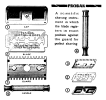- Messages
- 15,855
- Location
- Halifax, Republic of Yorkshire
I have the top left version in a rusty tin, it shaves really well, is it considered mild or aggressive compared to other razors, is the blade gap known, any info about it would be much appreciated.After much trawling on a well known auction site over the past couple of years, I've managed to cobble together a set of vintage (1930 - 1940's?) 7 o'clock razors in all the different packaging types I'm aware of.
The bakelite razor is a rebranded Gillette Tech and the others are all rebranded Gillette New Type Short Comb.
I found the green bakelite case and the tin difficult to source in good condition. I have another one of these tins where the writing can barely be read but I've also seen some that are practically spotless but, unfortunately not for sale.
I have a few spare bits razor left over from my quest and I'm always ready to replace what I have here with better condition parts but on the whole, I feel like I'm in a good place with what I have for now.
View attachment 78255
View attachment 78256
The blade gap is almost non-existant with the open comb providing the blade contact. You need to use a very shallow angle with the handle near a right-angle to your face to get the best results from it. It's very efficient and can bite if you're not careful. I've only used it a couple of times but I recall one side seemed to be more aggressive than the other. Not sure if that's misalignment through age or whether it's by design. It's a truly great razor and one of Gillette's best designs.I have the top left version in a rusty tin, it shaves really well, is it considered mild or aggressive compared to other razors, is the blade gap known, any info about it would be much appreciated.
I read that 7 oclock produced / invented the new slotted blade that we use today, is that correct.
The blade gap is almost non-existant with the open comb providing the blade contact. You need to use a very shallow angle with the handle near a right-angle to your face to get the best results from it. It's very efficient and can bite if you're not careful. I've only used it a couple of times but I recall one side seemed to be more aggressive than the other. Not sure if that's misalignment through age or whether it's by design. It's a truly great razor and one of Gillette's best designs.
I believe Gaisman was responsible for the slot design on the DE blade we use today. He was Chairman of Gillette at the time and also 7 o'clock as a subsidiary Company. The Gaisman rise to power is another story full of industrial intrigue that you could make a movie from. I would be surprised if the first slotted blade was anything other than Gillette branded.
I believe Gaisman was responsible for the slot design on the DE blade we use today. He was Chairman of Gillette at the time and also 7 o'clock as a subsidiary Company. The Gaisman rise to power is another story full of industrial intrigue that you could make a movie from. I would be surprised if the first slotted blade was anything other than Gillette branded.

In 1928 Henry J. Gaisman founded the Probak Corp. as a division of his AutoStrop Safety Razor Co. Probak started to manufacture razors and blades similar to Gillette's. Probak blades would work in both Probak and Gillette razors. Probak razors, however, would not accept Gillette blades. Instead of having round pins in the cap, the razors had a pair of depressions that accepted the variously shaped studs that were on the guard. There were eight different guard designs with differently shaped studs. In addition, the cap had corner blade-alignment pins that nested into depressions in the guard. The blade, in order to fit, had to have correctly placed openings to accept the protrusions and the corner pins. A similar scheme had been used in the 1920s by Gaisman's AutoStrop Company in a vain attempt to prevent competitors from making a blade that would fit the AutoStrop Valet single-edge razor.
Meanwhile (1929-1930), the Gillette Safety Razor Company was working on a similar razor and blade combination. The old three-hole blades would not fit in the new NEW GILLETTE, but the new, patented, slotted blade would still work in all the old Gillette razors. The outcome was a patent fight that ended up with Gillette buying the AutoStrop Co.
Many creative cap and guard designs were made in the 1930s by Gillette and Probak (by then a division of Gillette). The Gillette variations were dubbed Goodwill razors and they gave away 3 million of them free when you bought a $1 package of 10 New Gillette blades. (See The Complete Gillette Collector's Handbook, by Phillip L. Krumholz, pages 307, 402-404, and 234-240.)

Thats an amazing write up, the best explanation I have seen.
How Gillette's founder dreamed of a car-free, moneyless metropolis
Long before the razor firm’s ‘toxic masculinity’ advert, its founder advocated replacing all North American cities with a single socialist utopia beside Niagara Fallswww.theguardian.com
Gillette proposed replacing all North America’s cities with one giant city, built above, and powered by, Niagara Falls – an extreme version of the high-density designs advocated by many urban theorists and “re-wilding” conservationists today.
“Under a perfect economical system of production and distribution … there can be only one city on a continent, and possibly only one in the world,” he wrote. While citizens might temporarily occupy countryside or coastal dwellings for field labour or pleasure, the city, named Metropolis, would be their only permanent home, housing at least 60 million people at any one time.
Gillette described an urban area stretching from Niagara Falls around 60 miles eastwards into New York state, and a similar distance westwards from the falls into Ontario. His vision for renewable power might be considered ambitious even today.